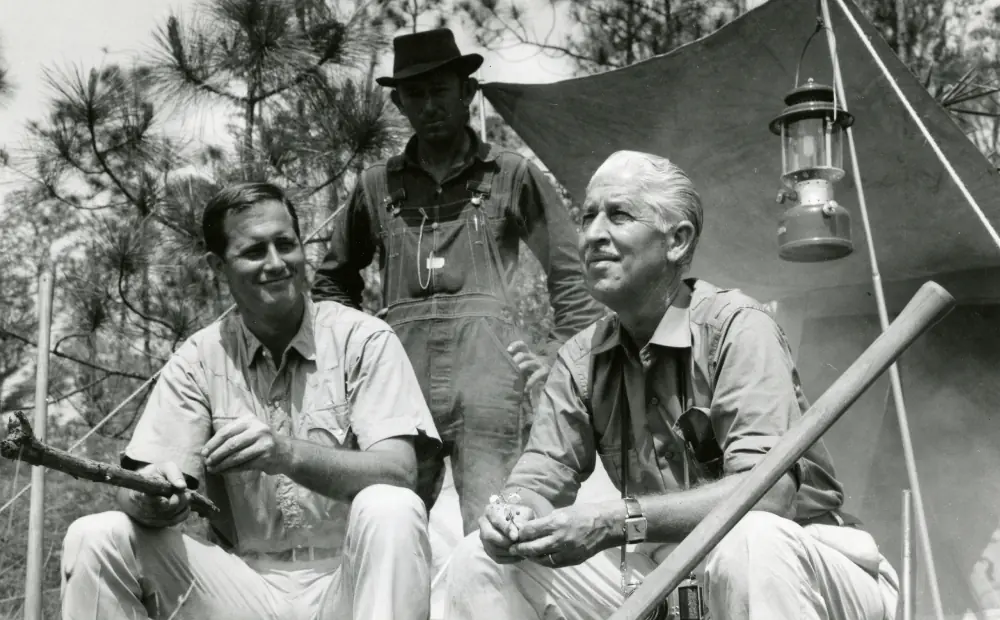0:00
Wildlife conservation is endlessly complex, and it requires a deep understanding of animal behavior.
0:08
Monitoring the movements and migration of species is critical science, and new technology is making the tracking process safer, more efficient and more accurate all the time.
0:23
Today I'm meeting up with Doctor Chris Lowe from California State University, Long Beach.
0:29
He heads up a research unit called the Shark Lab.
0:32
They're going to take me out on the water today, we're going to tag sharks and they'll teach me all about their data collection.
0:37
Can't wait.
0:39
The Shark Lab has been a pioneer in shark tacking technology for more than 40 years.
0:45
And in 1979, Mutual of Omaha's Marlin Perkins was along for the ride to help deploy some of the first ever shark tracking devices.
0:55
The transmitter is inserted inside a parrotfish, which a shark will swallow.
1:00
Although revolutionary at the time, the first tracking devices were large, had limited range, and only lasted a few days.
1:10
Things are much different today.
1:13
I'm with the director of the Shark Club, Doctor Chris Lowe and his team of research students from California State University, Long Beach with a nice send off from harbor Pelicans.
1:25
We traveled south of Santa Barbara to a white shark hotspot location known as Pedaro Beach.
1:32
We have some of your team members on this boat and what is the goal for today?
1:37
So the goal for us today is to continue doing what we've been doing for the last six years and that is tag more sharks so we can monitor their behavior.
1:46
So this is one of our acoustic transmitters.
1:48
Each transmitter has a unique ID, so as the shark is moving through the water, we not only know where it is in proximity to a receiver, but we know the depth that it's at.
1:58
And then this is the dart.
1:59
This gets darted into the shark's back, and sharks have very tough skin, so this isn't painful or traumatic for them.
2:05
Think about getting your ears pierced.
2:06
I've done that.
2:07
We we think it's very analogous to that.
2:09
You'll get a little flinch.
2:10
And then after that, our biggest challenge is not tagging the same shark twice.
2:15
Doctor Lowe utilizes a network of 120 acoustic receivers scattered along California's coast.
2:22
These receivers listen for signals from shark transmitters and relay scientists real time data about shark behavior.
2:32
I have a job for you today.
2:33
Oh, yeah? You're going to be our underwater camera person who's going to help us determine whether they're males or females.
2:40
And the way we do this is we have a camera on the end of a pole and you're going to dip that underneath so we can see the under part of the shark.
2:47
I understand my assignment.
2:49
I want to see how it's done.
2:50
All right, let's do it.
2:52
We're using a drone piloted by Chris's student Patrick to help us locate juvenile great whites in the shallow water.
3:02
All right.
3:03
It's a little deep right there.
3:04
Can you see it?
3:05
And we're coming up on.
3:06
Oh, I see.
3:06
It's got a tag in it.
3:07
It's got a tag.
3:09
This shark is already tagged, so it's the perfect opportunity for me to try my skill with the camera.
3:15
Get a little closer, almost aim, like, for its pec fins or belly, and then when it spins, it'll like swim over the camera.
3:22
You are you're magic.
3:26
There you go.
3:27
You got it.
3:29
She got it on her first time.
3:30
Did I get it?
3:31
Oh, absolutely.
3:32
That was a big shark.
3:34
That's a baby.
3:34
That's a baby.
3:37
That's a toddler.
3:38
So I have to ask the shark.
3:40
I saw it and I saw it's tag in its dorsal fin.
3:43
Is that your tag?
3:44
Yes.
3:45
So we just happened to find a shark that you've met before.
3:48
Wow.
3:49
The search is on for an untagged juvenile.
3:53
And here comes one now.
3:55
Oh, yeah.
3:55
Ok, that's definitely workable.
3:56
All right, perfect.
3:57
It's coming up.
3:58
Get ready a little bit more.
4:00
A little bit more.
4:00
Go, go, go, go.
4:01
Yeah.
4:01
Yeah, yeah.
4:02
Go, go.
4:03
Yeah.
4:06
Ok, we got a female. Nice job with the dip can.
4:10
You crushed it.
4:11
It was not easy.
4:12
But you are coaching me.
4:14
You are an awesome dip cam coach.
4:17
Now that this great white shark has been identified, it's up to Chris to deploy the tracking tag.
4:23
Yeah, right in the glare.
4:27
Oh, go, go, go.
4:30
Whoa, oh, you got it. Tag away, tag away.
4:33
Heck yeah.
4:33
Good. Chris and our animal tagging adventure is just getting started.












